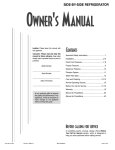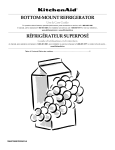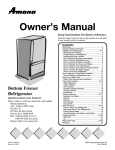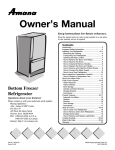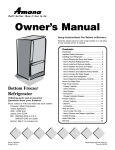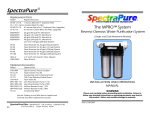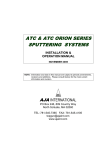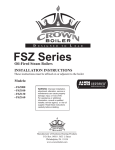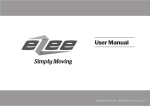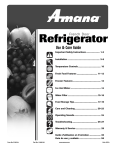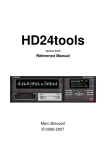Download Maytag 12591308 Refrigerator User Manual
Transcript
Owner's Manual Side by Side Refrigerator English ........................................................... 2 Deutsch ....................................................... 27 Français ....................................................... 51 Sección española ......................................... 75 Svenskt avsnitt ............................................. 99 Suomalainen osa ....................................... 123 Nederlands ................................................. 147 Sezione italiana ......................................... 171 Norsk seksjon ............................................ 195 Dansk afsnit ............................................... 219 Åã÷åéñßäéïÉäéïêôÞôç .................................... 243 Secção portuguesa .................................... 267 Türkçe ........................................................ 291 Part No. 12591308 Printed in U.S.A. 02/02 Please read this Owner's Manual thoroughly. This manual provides proper maintenance information. Warranty service must be performed by an authorized servicer. The manufacturer also recommends contacting an authorized servicer if service is required after warranty expires. To locate an authorized servicer, contact your distributor. When contacting your servicer, please provide the following information. Product information is on the serial plate, located on ceiling of fresh food section. Model Number _____________________________________________________ 'P' Number ________________________________________________________ Serial Number _____________________________________________________ Purchase Date _____________________________________________________ Dealer Name ______________________________________________________ Dealer Address _____________________________________________________ Dealer Phone ______________________________________________________ Contents Introduction .............................................................................. 2 Contents .................................................................................. 2 Important Safety Information ................................................... 3 Installing Your Refrigerator ...................................................... 4 How to Transport Your Unit ................................................. 4 How to Select the Best Location ......................................... 4 How to Install and Remove Handles .................................. 5 How to Level Your Refrigerator ............................................ 6 How to Adjust the Temperature Controls ............................ 7 About Your Filtration System ................................................... 8 Refrigerator Features .............................................................. 9 Interior Shelves .................................................................... 9 Door Storage ...................................................................... 10 Drawers ............................................................................. 11 Freezer Features ................................................................... 12 Primary Features ............................................................... 12 Shelves .............................................................................. 13 Door Storage ...................................................................... 13 Dispenser Features .............................................................. 14 Primary Features ............................................................... 14 Water Dispenser Operation .............................................. 14 Control Features (5-button control) ................................... 15 Control Features (Electronic control) ................................ 16 Hints and Care ...................................................................... 19 How to Clean Your Unit ..................................................... 19 How to Remove and Replace Light Bulbs ........................ 20 Before Calling Service ........................................................... 21 Water Filter Data .................................................................... 25 How to Obtain Replacement Parts and Services? Problems? Save yourself the nuisance of unnecessary service calls; check the “Before Calling Service” section of the owner’s manual. Your new refrigerator has been carefully engineered and manufactured under strict quality standards and should give you satisfactory and dependable operation. However, like all mechanical merchandise, it may occasionally require adjustment, replacement parts, or maintenance. Should you ever need assistance, please contact the dealer from whom you purchased the refrigerator. Provide the following: • Model • Manufacturing Number • Serial Number and all of the other data shown on the model serial plate. • State briefly the trouble you are having. The page area to the left has been provided to record valuable information. This book is intended to show the variety of features that are available in the product line. If interested in purchasing additional items available for your unit, please contact your distributor. 2 3 Installing Your Refrigerator These instructions were provided to aid you in the installation of your unit. The manufacturer cannot be responsible for improper installation. Steps to Follow... A qualified engineer must connect refrigerator in accordance with these installation instructions. Measure door opening and depth and width of refrigerator. Remove handles or doors if required. Engineer must also do the following: 1. Follow local water and electrical company connection regulations. 2. Complete water supply connection before electrical supply connection. Service to or replacement of power cord must be performed by a qualified servicer. Installation Requirements 1. Install on an earthed outlet with a separate 230-240 volt, 50hz., 10A circuit Y-connection type power cord. 2. Protect soft flooring with cardboard or rugs. 3. Install on a floor which supports up to 429 kg. 4. Provide 5 mm clearance at side of refrigerator and for models more than 60 cm deep, provide 25 mm clearance at top of refrigerator. 5. 60 cm deep models. Trim corners of counter top to a 45° angle if counter top has 25 mm overhang. How to Remove Wooden Base ! CAUTION To avoid personal injury or property damage, two people must remove wooden base. 1. 2. 3. Tape doors shut to prevent doors from opening unexpectedly. Slide appliance cart under side of refrigerator. Wrap refrigerator with blanket or pad. Thread strap around refrigerator. Put foam shipping pads, located in shipping carton, under strap. Tighten strap securely. 4. Lower appliance cart to floor with appliance cart handles on bottom. 5. Remove top two bolts from skid. 6. Return refrigerator and appliance cart to an upright position. Remove strap. 7. Slide appliance cart under opposite side of refrigerator. 8. Repeat steps 3–5. 9. Remove wooden base. 10. Return refrigerator and appliance cart to an upright position and remove appliance cart. IMPORTANT: Do not leave refrigerator on its side longer than necessary to remove bolts. How to Remove and Replace Doors and Hinges • Contact a qualified engineer to perform this task. 4 Installing Your Refrigerator How to Install and Remove Handles Handles are located within fresh food section of refrigerator. Trim, plugs, and accent pieces will be located within the literature assembly. Full-Length Grab Handles (non-stainless steel) 1 Remove two 1/4" hex nut screws from bottom of refrigerator and freezer door. 2 Align door handles with top and bottom sets of door clips, and slide down until screw holes on bottom of handles match with door screw holes. 3 Insert screws removed in step 1 into screw holes at bottom of handle section. 4 Snap trim over bottom portion of handles and retainers on bottom of door To remove after initial install... • Follow steps 3 through 4 in reverse order. NOTE: Fit may be tight. When removing handle, pull up and out. Half-Length Grab Handles (non-stainless steel) 1 3 Remove four 1/4" hex nut screws from top and bottom of doors. Snap colored handle trim over screw holes at top and bottom of handles. • Snap in trim by inserting large round end first. To remove after initial install... 2 Handles may need to be removed if transporting unit through tight spaces. • Follow steps 2 and 3 in reverse order. IMPORTANT: To avoid damage to handle, use a flat blade screwdriver edge wrapped in masking tape to remove colored handle trim. Align door handles with screw holes and insert screws removed in step 1. Stainless Steel Models 1 Loosen lower door clip on refrigerator door with 1/4" hex nut driver. 3 Fit other end of handle over upper door clip and slide up as far as possible. 2 Locate predrilled hole at base of handle, and fit hollow end of handle over lower door clip. 4 Insert 1/4" hex nut driver into predrilled hole at base of handle and tighten screw. 5 Installing Your Refrigerator How to Install the Handles continued How to Connect the Water Supply • Contact a qualified engineer to perform this task. How to Level Your Refrigerator ! CAUTION • To avoid damage to walls and flooring, protect soft vinyl or other flooring with cardboard, rugs, or other protective material. • To avoid damage or breakage to adjusting bolt, do not use power tools to correct leveling. • DO NOT adjust unit to be any shorter than 173.9 cm tall (minus hinge and cap). Doing so may damage underside components. Materials Needed • 3 /8" hex head driver 1 • Level 3 Remove Toe Grille and Bottom Hinge Covers • Open both doors 180°, or as wide as possible, to remove. 2 Turn both front adjustment screws (A) clockwise to raise and counterclockwise to lower. 4 Turn both rear adjustment screws (B) clockwise to raise and counterclockwise to lower. Check with level to verify 6 mm tilt to the back for proper door closure. • If unit is aligned and stable, replace toe grille. A What if my doors are not aligned? What if my unit rocks? • • • • B Locate the higher door, and turn front adjustment screw counterclockwise. Continue until doors are level. If bottom of adjustment range is reached, and doors are not level–raise opposite door by turning front adjustment screw clockwise. Replace toe grille • 6 Turn rear adjustment screw clockwise to raise rocking corner. Replace toe grille. Installing Your Refrigerator r Fr e ez e How to Adjust the Temperature Controls 1 4 Locate refrigerator and freezer controls on upper left wall of fresh food section, and set both controls to 4. • • • IMPORTANT: Neither section will cool if freezer control is set to Off. 2 5 Allow 24 hours for temperatures to stabilize. Turn control to next highest number if too warm. Turn control to next lowest number if too cold. Allow 5 to 8 hours for adjustments to take effect. Repeat process, as necessary. Materials needed • 2 thermometers measuring -21° to 10°C • 2 drinking glasses Check to see if freezer temperature is -17° to -16° C. • • • For Freezer • Place thermometer in glass of vegetable oil in middle of freezer and continue with step 3 of Temperature Adjustment section. Turn control to next highest number if too warm. Turn control to next lowest number if too cold. Allow 5 to 8 hours for adjustments to take effect. Electronic Temperature Control Models 1 To set temperature of the freezer, use the • 2 3 buttons next to the button. A setting of 0° to 2° F (-17° to -16° C) is recommended. • Use the Press the button to raise the temperature of the freezer section, or the to lower it. button to confirm the settings. To set temperature of the fresh food section, use the buttons next to the button. A setting of 38° to 40° F (3° to 4° C) is reommended. • Use the • Press the tor ra How do I perform a temperature test? IMPORTANT: Due to design of unit, always start temperature adjustments with freezer section. 3 Check to see that fresh food section is 3° to 4° C. Refr ige This refrigerator is designed to operate at a household temperature of 16° to 43° C. button to raise the temperature of the fresh food section, or the to lower it. button to confirm the settings. Allow 24 hours for temperatures to stabilize. NOTE: If adjusting the temperature of an operational unit, only 5 to 8 hours is required for temperatures to take effect. 7 For Refrigerator • Place thermometer in glass of water in middle of unit and continue with step 3 of Temperature Adjustment section. About Your Filtration System... Water Filter Removal and Installation ! WARNING To avoid serious illness or death, do not use unit where water is unsafe or of unknown quality without adequate disinfection before or after use of filter. ! CAUTION • Bypass cartridge DOES NOT filter water. Be sure to have replacement cartridge available when filter change is required. • If water filtration system has been allowed to freeze, replace filter cartridge. • If system has not been used for several months, and water has an unpleasant taste or odor, flush system by dispensing 2–3 glasses of water. If unpleasant taste or odor persists, change filter cartridge. Initial Install of Water Filter 1 2 • 3 • Replacing Water Filter IMPORTANT: Air trapped in system may cause water and cartridge to eject. Use caution when removing. Remove blue bypass cap and retain for later use. Remove sealing label from end of filter and insert into filter head. Rotate gently clockwise until filter stops and snap filter cover closed. Reduce water spurts by flushing air from system. Run water continuously (approximately 2 minutes) through dispenser until water runs steady. 1 Turn filter counterclockwise until it releases from filter head. 2 Drain water from filter into sink or toilet, and dispose in normal household garbage. 3 Wipe up excess water in filter cover and continue with installation steps 2 and 3. When do I change the water filter? Additional flushing may be required in some households where water is of poor quality. I'm trying to dispense water to flush the system. Where's the water? Select dispenser models feature a water filter change indicator. For instructions on how to operate and reset this feature, refer to the dispenser features section in your manual. For units without indicator feature, filter should be changed approximately every 6 months. IMPORTANT: Condition of water and amount used determines life span of water filter cartridge. If water use is high, or if water is of poor quality, replacement may need to take place more often. During initial use, allow about a 1 to 2 minute delay to allow internal water tank to fill. What if I choose not to use the water filtration system? How do I order a replacement filter cartridge? Dispenser feature may be used without water filter cartridge. If you choose this option, replace filter with blue bypass cap. Replacement Water Filter cartridge model OWF51 is available through your dealers and servicers. Contact your local distributor for more information. 8 Fresh Food Features 9 Fresh Food Features Door Storage Beverage Chiller™/ Mini-Chiller™ (some models) Dairy Center The dairy center provides convenient storage for items such as butter, yogurt, cheese, etc. This compartment is an adjustable feature located in the door. It can be moved to several different locations to accommodate storage needs. • To remove, slide dairy center up and pull straight out. • To install, reverse above procedure. The Temperature-Controlled Beverage Chiller™ and Temperature-Controlled Mini Beverage Chiller™ keep beverages and other items up to 3°C colder than the rest of the fresh food section. Air inlet allows air from the freezer section to pass to Beverage Chiller™. The Beverage Chiller™ control is located on the left wall of fresh food section. Control adjusts amount of air circulating in Beverage Chiller™. Turn control toward the large snowflake icon for colder temperature. Tilt-Out Door Buckets (some models) The Tilt-Out Bucket assembly consists of a bucket and frame, providing adjustable, convenient storage for food items in door. The bucket assembly tilts forward for easy access of items, and lifts out for ease in cleaning and adjusting. To remove and install Beverage Chiller™: • If located directly above Chiller, dairy center or door bucket may need to be removed. Refer to appropriate instructions and remove item. Slide Beverage Chiller™ assembly up and pull straight out. To remove and install bucket: • • • To remove bucket, tip bucket forward and pull straight out to remove. To install bucket, slide bucket into bucket frame and push bucket upright. To adjust bucket frame: • Remove bucket per above instructions. • Lift frame off door support and place in desired door location. To install, align one of the Beverage Chiller™ cold air intake holes (A) with one of the two air inlets (B) in door A liner. Push assembly down onto door liner retainer until it stops. B IMPORTANT: Beverage Chiller™ will not operate properly if air intake holes are not aligned with air inlet in door liner. Door Buckets Door buckets adjust to meet individual storage needs. Grip Pads The Grip Pads prevent objects from sliding in the door bucket. Grip Pads are removable and are top-rack dishwasher safe for easy cleaning. 10 • To remove, slide bucket up and pull straight out. • To install, reverse above procedure. Fresh Food Features Drawers Deli/Crisper Drawer climate controlled The Deli/Crisper system provides a drawer with a variable temperature control that keeps the compartment up to 3°C colder than refrigerator temperature. This drawer can be used for deli storage or additional produce storage. NOTE: Cold air directed to the Deli/Crisper System can decrease refrigerator temperature. Refrigerator control may need to be adjusted. Controls Located on the wall to the left of the drawer, the climate controls regulate the air temperature in the Deli/Crisper drawer. Set control level to cold to provide normal refrigerator temperature for produce with outer skins. Use the coldest setting for meats or other deli items. Crisper Drawer climate controlled Garden Fresh™ crisper keeps produce fresh longer by providing an environment with adjustable humidity. Controls The Garden Fresh™ controls regulate the amount of humidity in the crisper drawer. Use the low setting for produce with outer skins. Use the high setting for leafy produce. To remove and install drawers: • To remove drawer, pull drawer out to full extension. Tilt up front of drawer and pull straight out. • To install, reverse above procedure. To remove and install crisper shelf: • Lift off wall supports and remove. • To install shelf, lower shelf onto wall supports and push in until shelf is flush with rear wall. 11 Freezer Features Automatic Dispensing Ice Maker Ice Cream Shelf This ice maker creates the ice used in the dispensing system. The Ice Cream Shelf provides a space for items to be chilled or frozen quickly. Using Ice Maker for the First Time • Confirm ice bin is in place and ice maker arm is down. • To remove, lift Ice Cream Shelf from ice bin rails and pull straight out. • After freezer section reaches between -18° to -17° C, ice maker fills with water and begins operating. • To install, reverse above procedure. • Allow approximately 24 hours after installation to receive first harvest of ice. Ice Storage Bin • Discard ice created within first 12 hours of operation to verify system is flushed of impurities. The ice storage bin is located below the automatic dispensing ice maker. To remove and install ice storage bin: • To remove bin, remove Ice Cream Shelf. Raise ice maker arm to deactivate ice maker. Operating Instructions • Confirm ice bin is in place and ice maker arm is down. • After freezer section reaches -18° to -17° C, ice maker fills with water and begins operating. You will have a complete harvest of ice approximately every 3 hours. • Stop ice production by raising ice maker arm until click is heard. • Ice maker will remain in the off position until arm is pushed down. • Lift front of bin and pull out to its full extension. Lift up front of bin and remove. • To install, slide bin into rails below ice maker until bin locks into place. Drop ice maker arm to activate ice maker, and replace Ice Cream Shelf. IMPORTANT: Ice bin must be locked in proper place for proper ice dispensing. If freezer door does not close, bin is not in proper location. Turn auger driver as shown to properly align ice bin with back of unit. 12 Freezer Features Shelves Stor-Mor® System Baskets slide out for easy access of items in back. Shelves can be removed to meet individual storage needs. To remove and install Stor-Mor® shelf: • To remove, snap right side of shelf from cabinet railing and remove from wall mounting clips. • To install, reverse above procedure. NOTE: Back of shelf must be flush with back of cabinet to secure firmly in cabinet railing. Improper alignment will cause shelf to slide. To remove and install baskets: • To remove, pull basket forward to full extension. Lift front handle to release basket from rails and remove. • To install, reverse above procedure. Door Storage 13 Dispenser Features Control Features (Five button control) Ice Dispenser Operation To dispense ice: • Select Cubed or Crushed ice mode by pushing button on dispenser control panel. A green indicator light above button shows mode selection. • Press container against dispenser pad. When dispensing crushed ice, hold container as close to chute as possible to reduce spraying. Selection mode may not be changed while ice dispenser is in operation. NOTE: If dispenser is active for more than 3 minutes, an automatic lock out sensor will shut down power to dispenser area. See Automatic Lock Out for further information. What is the Automatic Lock Out feature? Dispenser Lock This feature prevents ice or water from being dispensed. To lock and unlock dispenser: • To lock dispenser, press and hold Dispenser Lock button for 3 seconds. A green indicator light above button confirms dispenser is locked. • To unlock dispenser, hold Dispenser Lock button for 3 seconds. Green indicator light above button will go out. The Automatic Lock Out feature shuts down power to the water and ice dispenser when either dispenser has run continuously for approximately 3 minutes. If this mode goes into effect, the green light will activate above the Dispenser Lock button. To unlock dispenser: • To unlock dispenser, hold Dispenser Lock button for 3 seconds. Green indicator light above button will go out. Filter Status Indicator Light The Filter Status Indicator Light serves as a reminder to replace the water filter. A green light indicates that the filter is in good condition. A red light indicates the filter should be changed. Once light turns red, it will remain red until function is reset. To reset indicator: • Press and hold both Dispenser Lock and Water buttons simultaneously for 4 seconds. The green Filter Status Indicator Light will flash 3 times when the function has successfully reset. Auto Light The Auto Light function offers the ability to activate the dispenser light at half-power when the Light Sensor detects that the light levels in room are low. To activate and deactivate Auto Light: • To activate, press Auto Light button located on control panel. A green indicator light above button displays to show that sensor is active. • To deactivate, press Auto Light button. Green indicator light will go out. NOTE: Dispenser light will operate whether or not Auto Light is selected. Sabbath Mode (some models) This mode is intended to deactivate power to the LED and dispenser lights, while allowing the controls to remain operational. To activate Sabbath Mode: • Press and hold both Dispenser Lock and Auto Light buttons simultaneously for 3 to 4 seconds. After 3 to 4 seconds, the LED and dispenser lights will turn off. Dispenser light will not activate during dispensing while in this mode. + NOTE: In the event that power is interrupted while the Sabbath Mode is active, the control will remain in Sabbath Mode when power returns. To deactivate Sabbath Mode: • Press and hold both Dispenser Lock and Auto Light buttons simultaneously for 3 to 4 seconds. After 3 to 4 seconds, the LED and dispenser lights will activate. 15 Dispenser Features Control Features (Electronic control) Water and Ice Dispensing (main activator) The water and ice dispensing functions work independently of each other. To dispense ice: To dispense water: • Press the button • Press water activator • Press the button for crescent ice. • Press the button for crushed ice. Dispenser Lock This feature prevents ice or water from being dispensed. To lock and unlock dispenser: • To lock dispenser, press and hold the is locked. • To unlock dispenser, hold the button for 3 seconds. A green indicator light above button confirms dispenser button for 3 seconds. Green indicator light above button will go out. Light Function The Light function offers offers two setting: OFF and AUTO. NOTE: Dispenser light will operate at full power when ice or water functions are in use. The OFF setting allows the light to function only as a dispenser cavity light. The AUTO setting allows the SENSOR to measure the surrounding light levels and adjust the power of the cavity light accordingly. When the sensor registers lower light levels (night time, darkened kitchen), the cavity light will respond at 50% power. When the sensor registers high light levels (lighted kitchen, direct sunlight), the cavity light will not activate. To deactivate the AUTO setting: • button located on control panel. When the green indicator light above button display is off, the light will Press the function only when dispensing ice or water. • To activate the AUTO setting, press the button. When the green indicator light above the button display is on, the cavity dispenser light will use the AUTO setting. Filter Status Indicator Light The Filter Status Indicator Light serves as a reminder to replace the water filter. A green light indicates that the filter is in good condition. A red light indicates the filter should be changed. Once light turns red, it will remain red until function is reset. To reset indicator: • Press and hold both the and the buttons simultaneously for 4 seconds. The green Filter Status Indicator Light will flash 3 times when the function has successfully reset. What is the Automatic Lock Out feature? The Automatic Lock Out feature shuts down power to the water and ice dispenser when either dispenser has run continuously for approximately 2 minutes. If this mode goes into effect, the green light will activate above the To unlock dispenser: • To unlock dispenser, hold button. button for 3 seconds. Green indicator light above button will go out. 16 Dispenser Features Control Features continued (Electronic control) Temperature Keys These keys will lower or raise the freezer or fresh food compartment temperature. To set the fresh food temperature: • • To set the freezer temperature: Locate the next to the button. Use the • button to raise the temperature of the fresh food section, or the Max Cool Press the Repeat the above instructions with the the to lower it. button to confirm the setting. buttons next to button on the display. NOTE: The temperature setting cannot be changed if Max Cool or Max Freeze setting is active. This function causes the fresh food temperature to drop to the Minimum Refrigerator Temperature Setting preset by the control. This setting remains in effect for approximately 10 hours. To activate Max Cool: • Press the button. The green light above the button will indicate active status. Max Freeze To deactivate Max Cool: • Press the button. The green light above the button will turn off. NOTE: The temperature setting cannot be changed if Max Cool or Max Freeze setting is active. This function causes the freezer temperature to drop to the Minimum Freezer Temperature Setting preset by the control. This setting remains in effect for approximately 24 hours. To deactivate Max Freeze: • Press the button. The green light above the button will go out. To activate Max Freeze: • Press the button. The green light above the button will indicate active status. Display On/Off The Display On/Off switch controls power to the LED display. To deactivate display: • Press the button. The display will turn off. To reactivate display: • Press the button. The display will turn back on. Vacation Mode This key, if enabled, causes less frequent defrost cycles. This conserves energy. To place refrigerator into Vacation Mode: To deactivate Vacation Mode: • • Press the button. Alarm Off Press the button, or open either refrigerator door. To turn the alarm off: This key is used to turn the HI TEMP Warning Indicator and audio alarm, as well as the OPEN DOOR audio alarm off. • 17 Press the button. Dispenser Features Hidden Control Features (Electronic Control) Sabbath Mode This mode is intended to deactivate power to the LED and dispenser lights, while allowing the controls to remain operational. No visual or audio alarms will be available while in this mode. + To activate Sabbath Mode: To deactivate Sabbath Mode: and buttons • Press and hold both the and buttons simultaneously for 3 • Press and hold both simultaneously for 3 seconds. After 3 seconds, the seconds. After 3 seconds, the LED and dispenser lights will LED and dispenser lights will turn off. Dispenser light will not activate during dispensing while in activate. this mode. NOTE: In the event that power is interrupted while the Sabbath Mode is active, the control will remain in Sabbath Mode when power returns. Auto Display The AUTO Display controls the illumination of the LED display based on the light readings received from the SENSOR. In AUTO mode, if the SENSOR indicates low light levels, the display will be dimmer than if displaying during well-lit periods. In ON mode, the display will have only one illumination setting and will not change due to light levels. To set the power level of the display: • Press and hold both the the display by using button and the freezer button for 3 seconds. The current active state will show in O for on, AL for auto. • Use the refrigerator • Activate the chosen setting by pressing the button to scroll through the display states. button. Temperature Conversion Mode To change temperature reading: This mode is available to change the Temperature Display between Fahrenheit and Celsius. • Press the and freezer °F buttons simultaneously for 3 seconds. Pressing the same button combination will allow °C the user to toggle between the two selections . Hidden Lockout for Upper Keypad + The purpose of this mode is to prevent tampering with the upper set of dispenser controls. This includes the Display On/Off , Max Freeze, Max Cool, Vacation Mode, and Temperature Set functions. To activate Hidden Dispenser Lockout: To deactivate Hidden Dispenser Lockout: and buttons simultaneously for • Press the • Press the and buttons simultaneously 3 seconds. for 3 seconds. ON/OFF Function The ON/OFF function turns off cooling to the fresh food and freezer sections. To turn the unit off: • Press the freezer ! button until the readout registers To reactivate the unit: beyond the maximum allowable freezer temperature. At -- • Press the freezer button to confirm the selection. • Press the this point, the LED displays: -• Press the WARNING To avoid electrical shock which can cause severe personal injury or death, do not perform maintenance or service on refrigerator unless unit is unplugged. 18 button. button to confirm the selection. Hints and Care How to Clean Your Unit ! WARNING To avoid electrical shock which can cause severe personal injury or death, disconnect power to refrigerator before cleaning. After cleaning, connect power. ! CAUTION To avoid personal injury or property damage: • Read and follow manufacturer's directions for all cleaning products. • Do not place buckets, shelves, or accessories in dishwasher. Cracking or warping of accessories may result. • Handle tempered glass shelves carefully. Shelves may break suddenly if nicked, scratched, or exposed to sudden temperature change. • Protect soft vinyl or other flooring with cardboard, rugs, or other protective material. General 1. 2. Wash surfaces with a warm water and baking soda solution. Use a soft clean cloth to clean surfaces. Rinse surfaces with warm water. Dry surfaces with a soft, clean cloth. Adhesives 1. 2. Remove glue residue by rubbing toothpaste into adhesive with fingers until adhesive loosens. Rinse surface with warm water. Dry surface with a soft, clean cloth. Door Gaskets 1. Keep gaskets clean at all times. Clean door gaskets thoroughly every 3 months according to “General” instructions. Condenser Coils Clean condenser coil every 3 months to ensure maximum performance of refrigerator. Accumulated dust and lint may cause the following: • reduced cooling performance • increased energy usage • in extreme cases, premature compressor failure 1. Remove toe grille and bottom hinge covers as shown right. 2. Clean front surface of condenser coil with a vacuum cleaner hose nozzle. 3. Replace toe grille by inserting clips in holes and snapping in. Snap bottom hinge covers over bottom hinges. Glass Shelves Remove shelf by lifting front, releasing hooks from metal track then pulling out. Place shelf on a towel. Allow shelf to adjust to room temperature before cleaning. Clean crevices by completing the following steps: 1. Dilute mild detergent and brush solution into crevices using a plastic bristle brush. Let set for 5 minutes. 2. Spray warm water into crevices using faucet spray attachment. 3. Dry shelf thoroughly and replace shelf by inserting hooks into metal track and lowering front. 19 Hints and Care How to Remove and Replace Light Bulbs ! WARNING To avoid electrical shock which can cause severe personal injury or death, disconnect power to refrigerator before replacing light bulb. If unable to disconnet power by unplugging power cord then remove the fuse at mains. After replacing light bulb, connect power. ! CAUTION To avoid personal injury or property damage, observe the following: • Allow light bulb to cool. • Wear gloves when replacing light bulb. Upper fresh food section 1. Locate finger gaps on each side of clear light shield. Insert fingers and press in on each side of shield. Pull shield down and remove. 2. Remove light bulbs. 3. Replace with appliance bulbs, type Krypton E27, no greater than 25 watts. 4. Replace light bulb cover by inserting front tabs of light shield into holes in liner directly in front of light assembly. 5. Snap back of light cover into place. Lower fresh food section and Non-dispensing model freezer section B 1. Pinch bottom tabs (A) on light cover and pull straight out. 2. Remove light bulb. 3. Replace with appliance bulbs, type Krypton E27, no greater than 25 watts. 4. Insert top tabs (B) of light cover into refrigerator liner and snap bottom portion over light assembly. A Dispensing model freezer section 1. Remove ice bin by lifting front of bin and pulling out. A 2. Remove light bulb cover by pinching top tab (A) and pulling cover out of liner. 3. Replace with appliance bulbs, type Krypton E27, no greater than 25 watts. 4. Insert bottom tab (B) of light cover into liner and snap top portion over light assembly. B 5. Replace ice bin by sliding in until bin locks into place. Ice ’N Water dispenser 1. Locate light bulb inside top edge of dispenser frame. Unscrew to remove. 2. Replace bulbs with a 230/240VAC bulb no greater than 12 watts. Extra light bulbs are provided in crisper due to local unavailability. 20 Before Calling Service NOISE Today’s refrigerators have new features and are more energy efficient. Foam insulation is very energy efficient and has excellent insulating capabilities, however, foam insulation is not as sound absorbent. As a result, certain sounds may be unfamiliar. In time, these sounds will become familiar. Please refer to this information before calling service. TOPIC POSSIBLE CAUSE SOLUTION Clicking Freezer control (A) clicks when starting or stopping compressor. Defrost timer (B) sounds like an electric clock and snaps in and out of defrost cycle. Normal operation Air rushing or whirring Freezer fan (C) and condenser fan (D) make this noise while operating. Normal operation Gurgling or boiling sound Evaporator (E) and heat exchanger (F) refrigerant makes this noise when flowing. Normal operation Thumping Ice cubes from ice maker(some models) drop into ice bucket (G). Normal operation Vibrating noise Buzzing Humming Dispenser ice chute (H) closing. Compressor (I) makes a pulsating sound while running. Refrigerator is not level. Ice maker water valve (J) hookup (some models) buzzes when ice maker fills with water. Ice maker (K) is in the ‘on’ position without water connection. Ice auger (L) (some models) hums as auger agitates ice during dispensing. Compresser (I) can make a high pitched hum while operating. Solenoid valve (M) operating ice chute door. Normal operation K G L H M Normal operation Normal operation See Installation Instructions for details on how to level your unit. Normal operation D I E F J Stop sound by raising ice maker arm to ‘off’ position. See Automatic Ice Maker section in your owner’s manual for details. A Normal operation Normal operation C Normal operation OPERATION Freezer control and lights are on, but compressor is not operating. Deli/Crisper system temperature is too warm Refrigerator does not operate Refrigerator still won’t operate Fresh food temperature is too cold Refrigerator is in defrost mode. Normal operation Wait 40 minutes to see if refrigerator restarts. Control settings are too low. Freezer controls are set too low. See section on Deli/Crisper system to adjust controls. See controls section in Owner’s Manual on how to adjust your controls. See section on Deli/Crisper system to verify drawer positioning. Plug in unit. See section on controls in your Owner’s Manual. Replace any blown fuses. Check circuit breaker and reset if necessary. Call local power company listing to report outage. Unplug refrigerator and transfer food to another unit. If another unit is not available, place dry ice in freezer section to preserve food. Warranty does not cover food loss . Contact service for assistance. Clean according to cleaning instructions in your Owner’s Manual. See controls section in Owner’s Manual on how to adjust your controls. See section on Temperature-Controlled Beverage Chiller™ to verify proper positioning. Drawer is improperly positioned. Refrigerator is not plugged in. Freezer control is not on. Fuse is blown, or circuit breaker needs to be reset. Power outage has occurred Unit is malfunctioning. Condenser coils are dirty. Refrigerator or freezer controls are set too high. Beverage Chiller™ (some models) is improperly positioned. 21 B Before Calling Service OPERATION TOPIC POSSIBLE CAUSE SOLUTION Food temperature appears too warm Door is not closing properly. Refrigerator is not level. See Installation Instructions for details on how to level your unit. Check gaskets for proper seal. Clean, if necessary, according to cleaning instructions in Owner’s Manual. Check for internal obstructions that are keeping door from closing properly (i.e. improperly closed drawers, ice buckets, oversized or improperly stored containers or foodstuffs, etc.). See the controls section in your Owner’s Manual for assistance in how to adjust your controls. Clean according to cleaning instructions in your Owner’s Manual. Check the positioning of food items in refrigerator to make sure grille is not blocked. Rear air grille is located behind crisper drawers. Reduce time door is open. Organize food items efficiently to assure door is open for as short a time as possible. Allow interior environment to adjust for period the door has been open. Controls need to be adjusted. Condenser coils are dirty. Rear air grille is blocked on models over 60 cm deep. Door has been opened frequently, or has been opened for long periods of time. Allow time for recently-added food to reach refrigerator or freezer temperature. Refer to odor removal instructions in Owner’s Manual. Food has recently been added. Refrigerator has an odor Water droplets form on outside of refrigerator Compartment is dirty or has odorcausing food. Air filter (some models) needs to be changed. Check gaskets for proper seal. Change air filter. Clean, if necessary, according to cleaning instructions in Owner’s Manual. Normal during times of high humidity. See the controls section in your Owner’s Manual for assistance in how to adjust your controls. See the controls section in your Owner’s Manual for assistance in how to adjust your controls. Reduce time door is open. Organize food items efficiently to assure door is open for as short a time as possible. Clean, if necessary, according to cleaning instructions in Owner’s Manual. Refer to “Noise” section of Before Calling Service in your Owner’s Manual. Humidity levels are high. Controls require adjustment Water droplets form on inside of refrigerator Humidity levels are high or door has been opened frequently. Check gaskets for proper seal. Refrigerator or ice maker make unfamiliar sounds or seems too loud Normal operation Deli/Crisper System and/or crisper drawers do not close freely Contents of drawer, or positioning of items in the surrounding compartment could be obstructing drawer Reposition food items and containers to avoid interference with the drawers. Drawer is not in proper position See section on Deli/Crisper System and/or crisper drawer section for proper placement. See Installation Instructions for details on how to level your unit. Clean drawer channels with warm, soapy water. Rinse and dry thoroughly. Apply a thin layer of petroleum jelly to drawer channels. Refrigerator is not level. Drawer channels are dirty or need treatment. Refrigerator runs too frequently Doors have been opened frequently or have been opened for long periods of time. Reduce time door is open. Organize food items efficiently to assure door is open for as short a time as possible. Humidity or heat in surrounding area is high. Normal operation Food has recently been added. Allow time for recently-added food to reach refrigerator or freezer temperature. Unit is exposed to heat by environment or by appliances nearby. Evaluate your unit’s environment. Unit may need to be moved to run more efficiently. Condenser coils are dirty. Clean according to cleaning instructions in your Owner’s Manual. 22 Allow interior environment to adjust for period the door has been open. Before Calling Service OPERATION (continued) TOPIC POSSIBLE CAUSE SOLUTION Refrigerator runs too frequently (continued) Controls need to be adjusted. See the controls section in your Owner’s Manual for assistance in how to adjust your controls. Door is not closing properly Refrigerator is not level. See Installation Instructions for details on how to level your unit Check for internal obstructions that are keeping door from closing properly (i.e. improperly closed drawers, ice buckets, oversized or improperly stored containers or foodstuffs, etc.). Check gaskets for proper seal. Clean, if necessary, according to cleaning instructions in Owner’s Manual. ICE & WATER Water appears cloudy Air or air bubbles in water. This is normal when first using dispenser and will disappear with use. Particles in water and/or ice cubes. Carbon dust from water filter cartridge. Initial water ejected through cartridge may contain harmless carbon dust flushed from cartridge. Particles are safe for consumption. Will disappear after the first few uses. Concentrations of minerals in water will form particles when water becomes frozen and melts. Particles are not harmful and naturally occur in water supplies. Freezer door is not closed. Verify that freezer door is closed. Power is removed from the control when freezer door is opened. Refrigerator is not plugged in. Plug in unit. Fuse is blown, or circuit breaker needs to be reset. Replace any blown fuses. Check circuit breakers for any tripped circuits. No indicator lights are lit on dispenser control (some models) Neither ice nor water is dispensed when pads are pushed (some models) Ice maker is not producing enough ice or ice is malformed (some models) Ice maker is not producing ice (some models) Power outage has occurred. Call local power company listing to report outage. Freezer door is not closed. Verify that freezer door is closed. Power is removed from the control when freezer door is opened. Controls are in lock mode. See Dispenser control instructions. Water tank is filling. At initial use, there is an approximate 45-second delay in dispensing while the internal water tank is filling. Ice maker or ice maker-equipped unit has just recently been installed or a large amount of ice has just been used. Wait 24 hours for ice production to begin and for ice maker to restock after emptied. Water filter is clogged or needs to be changed. Change water filter. Ice maker has just recently been installed or a large amount of ice has just been used. Wait 24 hours for ice production to begin and for ice maker to restock after emptied. Water pressure is too low. Low water pressure can cause valve to leak. Water pressure must be between 20 to 100 pounds per square inch to function properly. A minimum pressure of 35 pounds per square inch is recommended for units with water filters. Water filter is clogged or needs to be changed. Change water filter. Ice maker arm is not in correct position Confirm ice maker arm is down. See Automatic Ice Maker section in your Owner’s Manual for details. Household water supply is not reaching water valve Check water connection procedure in your Installation Instructions. Water supply tubing has kinks. Turn off water supply and remove kinks. If kinks cannot be removed, replace tubing. Water pressure is too low. Water pressure must be between 20 to 100 pounds per square inch to function properly. A minimum pressure of 35 pounds per square inch is recommended for units with water filters. Check freezer temperature. See the controls section in your Owner’s Manual for assistance on how to adjust your controls. Freezer must be between 0 to 2°F (-18 to –17°C) to produce ice. Ice bin is not installed properly See ice bin section for proper installation and alignment. 23 Before Calling Service ICE & WATER TOPIC POSSIBLE CAUSE SOLUTION Ice maker is not producing ice (some models-continued) Improper water valve was installed. Check water connection procedure in your Installation Instructions. Self-piercing and 3/16” saddle valves cause low water pressure and may clog the line over time. The manufacturer is not responsible for property damage due to improper installation or water connection. Unit is leaking water Plastic tubing was used to complete water connection. The manufacturer recommends using copper tubing for installation. Plastic is less durable and can cause leakage. The manufacturer is not responsible for property damage due to improper installation or water connection. Improper water valve was installed. Check water connection procedure in your Installation Instructions. Self-piercing and 3/16” saddle valves cause low water pressure and may clog the line over time. The manufacturer is not responsible for property damage due to improper installation or water connection. Water pressure is low. Water pressure must be between 20 to 100 pounds per square inch to function properly. A minimum pressure of 35 pounds per square inch is recommended for units with water filters. Freezer temperature is too high. See the controls section in your Owner’s Manual for assistance on how to adjust your controls. Freezer is recommended to be between 0 to 2°F (-18 to –17°C). Water pressure is low. Water pressure must be between 20 to 100 pounds per square inch to function properly. A minimum pressure of 35 pounds per square inch is recommended for units with water filters. Improper water valve was installed. Check water connection procedure in your Installation 3 Instructions. Self-piercing and /16” saddle valves cause low water pressure and may clog the line over time. The manufacturer is not responsible for property damage due to improper installation or water connection. Water inlet tubing has kinks. Turn off water supply and remove kinks. If kinks cannot be removed, replace tubing. Water filter is clogged or needs to be changed. Change water filter. Refrigerator has been recently installed Allow approximately 12 hours for water in holding tank to chill. Ice forms in inlet tube to ice maker Water flow is slower than normal Dispenser water is not cold Water supply in holding tank has been depleted. Water has settle into water lines outside holding tank and has warmed to room temperature. 24 Discard first glass of water and refill. Water Filter Data System Specification and Performance Data Sheet Refrigerator Water Filter Cartridge Model OWF51 Specifications Service Flow Rate (Maximum) ............................................. 0.75 GPM (2.83 L/min) Rated Service Life OWF50-NI300 (Maximum) ..................... 300 gallons/ 1135 liters Rated Service Life OWF50-WI500 (Maximum) ..................... 500 gallons/ 1892 liters Maximum Operating Temperature ........................................ 100° F/38° C Minimum Pressure Requirement .......................................... 35 psi/ 138 kPa Minimum Operating Temperature ......................................... 33° F/ 1° C Maximum Operating Pressure .............................................. 120 psi/ 827 kPa General Use Conditions: Read this Performance Data Sheet and compare the capabilities of this unit with your actual water treatment needs. DO NOT use this product where water is microbiologically unsafe or of unknown quality without adequate disinfection before or after the system. System certified for cyst reduction may be used on disinfected water that may contain filterable cysts. The retractable water filtration system uses a OWF51 replacement cartridge (see your distributor to order). Timely replacement of filter cartridge is essential for performance satisfaction from this filtration system. Please refer to the applicable section in this Owner's Manual for general operation, maintenance requirements and troubleshooting. This systems has been tested according to ANSI/NSF 42 and 53 for reduction of the substances listed below. The concentration of the indicated substances in water entering the system was reduced to a concentration less than or equal to the permissible limit for water leaving the system, as specified in ANSI/NSF 42 and 53. Substance Lead Lead Cyst Turbidity Lindane Atrazine Chlorine Particulate** 2,4-D Asbestos * ** Average Influent challenge Effluent % Maximum Min. Required concentration Average Reduction Effluent Reduction 0.15 mg/L +/- 10% 0.001 mg/L 99.33% 0.001 mg/L 0.010 mg/L 0.15 mg/L +/- 10% 0.002 mg/L 98.66% 0.003 mg/L 0.010 mg/L Minimum 50,000/L 1count/mL 99.99% 3 count/mL > 99.95% 11 +/- 1 NTU 0.12 NTU 98.98% 0.18 NTU 0.5 NTU 97.62% 0.002 mg/L +/- 10% 0.00005 mg/L 92.06% 0.00005 mg/L 0.00001 2 mg/L 0.009 mg/L +/- 10% 0.0002 mg/L 97.93% 0.0006 mg/L 0.003 mg/L 2.0 mg/L +/- 10% 0.09 mg/L 95.26% 0.210 mg/L +/- 10% 900 count/mL 45.45 ug/L 99.68% 84.42% 107to108 fibers/L;fibersgreaterthan 10micometersinlength 0.16 MFL/mL 99.96% at least 10,000 particles/mL 0.17 mg/L ≥75% ≥85% 2400 count/mL 100 ug/L 0.0017 mg/L 0.16 MFL/mL 99% Inlet pH 6.5 8.5 NA NA NA NA NA NA NA NA Tested using a flow rate of 0.75 GPM (2.83 L/min.) and a maximum pressure of 120 psi (827 kPa) under standard laboratory conditions, however, actual performance may vary. Health Claim Performance tested and certified by NSF International Particle size range classification of test. Particles used were 0.5 –1 microns. Tested and Certified by NSF International against ANSI/NSF Standards 42 & 53 in models OWF50-WI500 and OWF50-NI300 for the reduction of: Pentapure, Incorporated 1000 Apollo Road Eagan, Minnesota U.S.A. EPA EST #35917-MN-1 ® Standard No. 42: Aesthetic Effects Taste & Odor Reduction Chlorine Reduction Mechanical Filtration Unit Particlate Reduction Class 1 25 Standard No. 53: Health Effects Chemical Reduction Unit Lead, Atrazine, Lindane & 2,4-D Reduction Mechanical Filtration Unit Cyst, Turbidity, & Asbestos Reduction

























